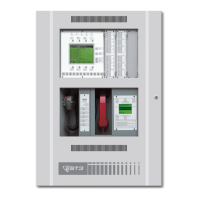Security applications
EST3 Installation and Service Manual 2.5
3-MODCOM Modem Communicator module
The 3-MODCOM Modem Communicator module has both
modem and dialer functions. It can transmit and receive
information.
The 3-MODCOM can transmit alarm, supervisory, or trouble
messages to a remote central monitoring station using one or two
telephone lines. A variation of the module (3-MODCOMP) can
transmit pager messages to a paging company using the TAP
protocol. The 3-MODCOMP remote paging feature is
supplemental and is not supervised.
The module can also receive information sent over telephone
lines by the Keypad Display Configuration program.
RPM Resource Profile Manager tool
The Resource Profile Manager (RPM) tool is part of the SDU. It
uses the project database to let you create a separate resource
profile for each company that will be using the security system.
The resource profile defines the security system for the KDC
program. It includes such information as:
• The KPDISPs in the system
• The routing required to access each KPDISP for downloads
• Which KPDISPs can execute fire alarm system commands
The resource profile is imported into the KDC program during
installation.
KDC Keypad Display Configuration program
The Keypad Display Configuration (KDC) program lets the
system user define and maintain a database of information about
KPDISPs, users, and access levels. This is part of the overall
security database.
The KDC program runs on the user’s PC. Additions or updates
to the security database can be transmitted to the KPDISP units
in two ways.
The first method is via modem and dial-up telephone line to
the3-MODCOM. The information is then routed to the CPU,
through the correct 3-SACs, and finally to the affected KPDISP
units.
The second method is by connecting the user’s PC directly to the
CPU using an RS-232 cable. The connection is made between
the PC’s COM1 port and any of the RS-232 terminals on the
CPU. As in the first method, after reaching the CPU additions
and changes are routed through the correct 3-SACs to the
affected KPDISPs.

